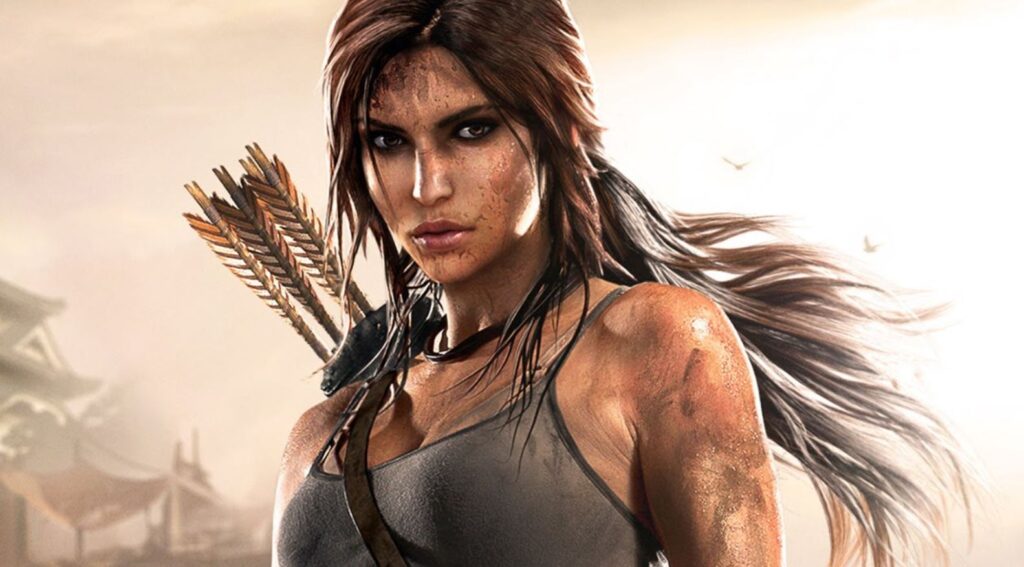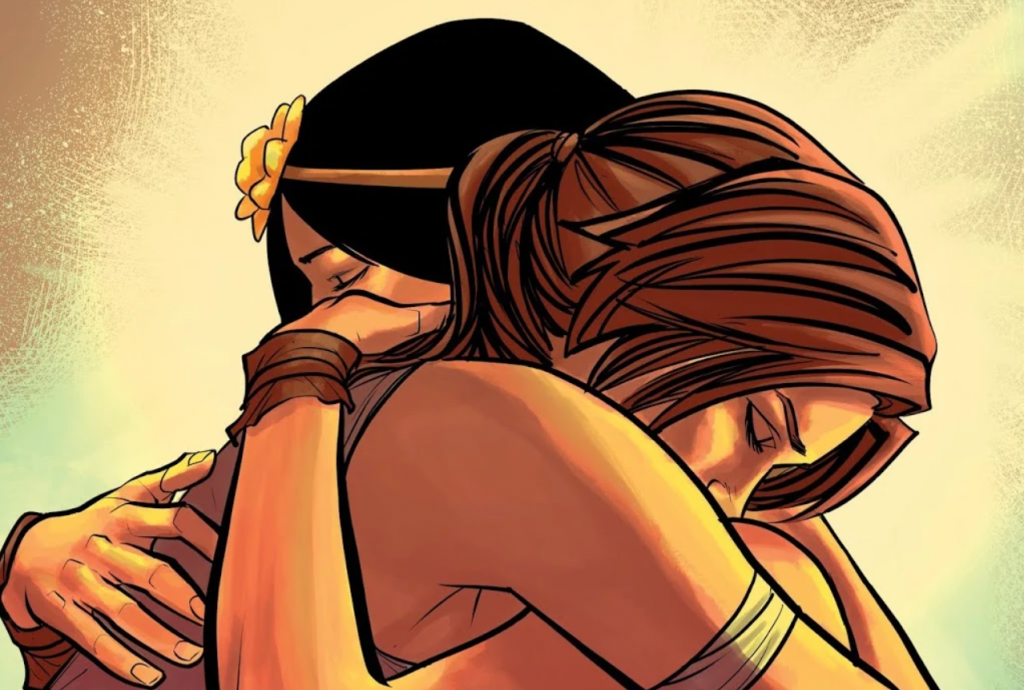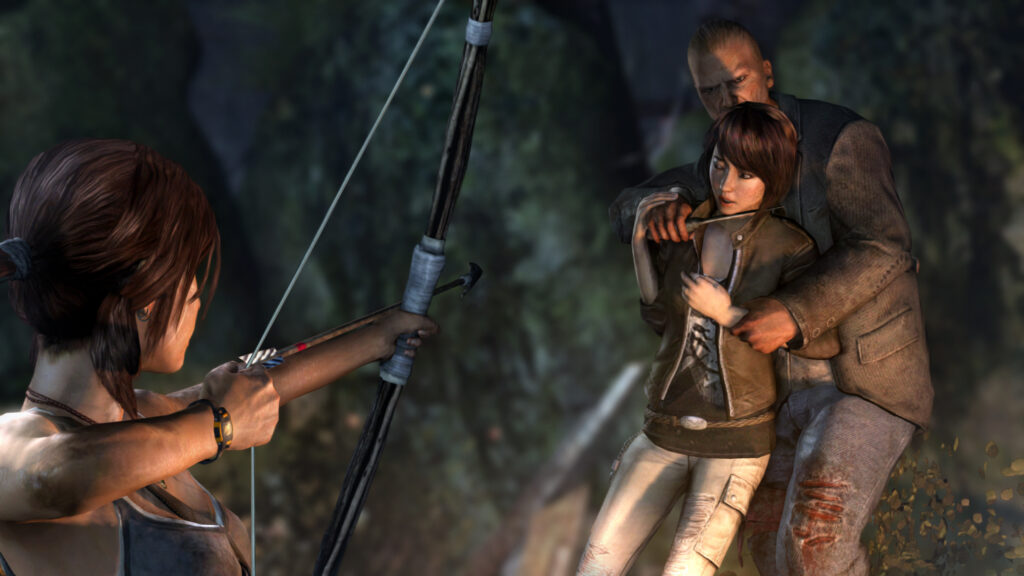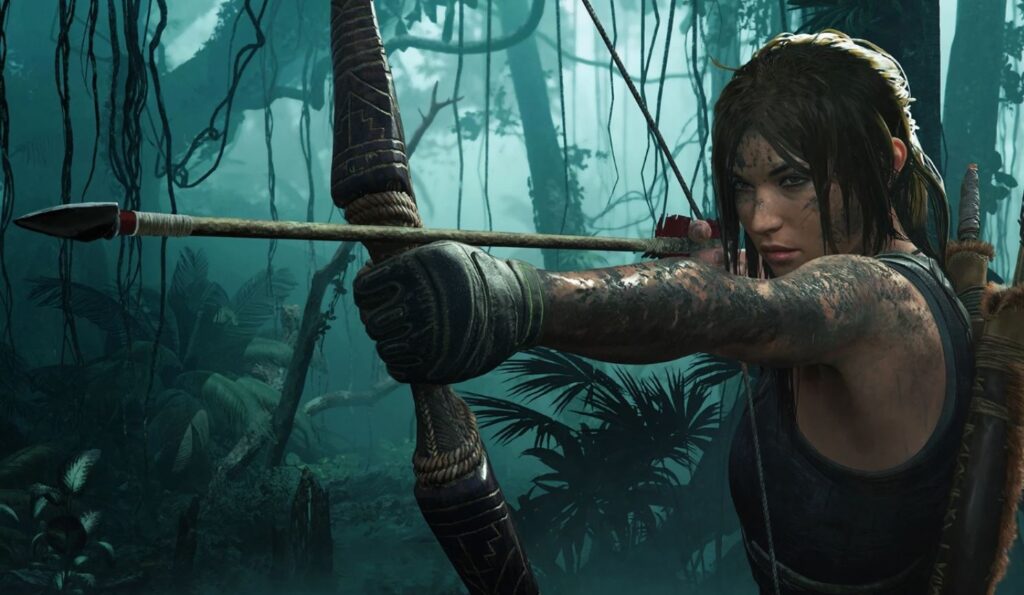
How racist storytelling in the Tomb Raider reboot games buried Lara Croft’s queerness
Last July, Tomb Raider: Inferno writer Jackson Lanzing told fans what they already knew on some level. During his acclaimed run on the Tomb Raider comic series, Lanzing had a story arc planned for Lara Croft where she would finally understand her feelings for Samantha “Sam” Nishimura, her longtime best friend and travelling companion. The revelation would come about during a toxic drug trip from hallucinogenic tree bark, and culminate in a passionate kiss between the two adventurers.
But that kiss never came.
“By the time it went to publishing,” Lanzing opined on Twitter, “their culminating kiss had become a friendly hug.”
Series artist Phillip Sevy backed up Lanzing’s claim. “I still have the original pencils/inks for that page before I had to redraw it,” he replied.
The admission stung, but at the very least, it was long overdue catharsis.

In 2013’s Tomb Raider, Lara and Sam’s relationship was put at the forefront. Players were led to believe that Sam was the center of Lara’s world through dialogue and audio logs. The two women went to school together, and Sam was very quick to pick up on Lara’s curiosity and sense of adventure. So when Sam got kidnapped by a racist cult, Lara’s fight to save her played out like a subversion of tired AAA “big boys save the weak girl” yarns. At the time there was something invigorating about a story where women looked after each other, and saved each other’s bacon. For all the reboot’s failings, that emotional core was resonant, and their chemistry was all but solidified by the game’s end.
Unfortunately, none of it amounted to anything. Sam wouldn’t appear again in either Rise of the Tomb Raider or Shadow of the Tomb Raider. In Rise, Lara’s therapist asks a single question about Sam.
“Have you reached out to the other survivors since your return?”
“You know I haven’t,” Lara replies. “Even if her doctors let me, she doesn’t want to see me.”
In a span of three years, Sam went from Lara’s longtime friend to an audio log footnote.
It was insulting. Yet it was somehow better than what went on in the first run of Dark Horse’s Tomb Raider comics. Sam was relegated to being a prop for Lara to save, feel guilty about, or have trauma over. Over the course of eighteen issues, she’s kidnapped (again,) possessed by an ancient spirit (again,) saved by Lara (again,) and kidnapped (for the third time.) The ancient spirit, which possessed her in the first game, eventually drives her into killing one of her attackers in a blind and brutal rage. This penchant for violence culminates in her eventual arrest for assault and incarceration in a mental ward.
In 2013, fans were hopeful for a relationship between Lara and Sam. But within a few years, it became clear those hopes were built on a rotted foundation, which collapsed and gave way to a storyline as infuriating as it was marginalizing. Tomb Raider used their primary Japanese character as a vector for orientalist takes on ancient mythology, and when she outlived her usefulness, she was slowly destroyed right in front of fans’ eyes. Her relationship with Lara eroded into one built entirely around trauma and resentment, while her fate was relegated to a comic series most players wouldn’t read.

When Dark Horse rebooted the series, acclaimed writer Mariko Tamaki did the best with what she was given. Sam escapes the mental asylum, only to get kidnapped (yes, again) by the shadowy Trinity organization. Trinity performs a series of experiments that, once again, allow Himiko to take full control of her body. However, the arc is handled in a way that feels more tactful than previous ones, as more time is given to Sam’s own suffering through the experience. Finally, she feels less like a plot device and more like an actual human being, which helps to reignite the chemistry between her and Lara. As the two women fight to save Sam’s soul, they learn, grow, and change together. After this, Lara hides Sam somewhere far away from Trinity’s clutches, and we’re left to wonder what could grow between them in some hypothetical future.
This where Jackson Lanzig came in. His Survivor’s Crusade and Inferno probed deep into Lara’s psyche, in what was clear preparation for the downtrodden and (sort of) self-reflexive tone of Shadow. Lanzig was one of the few writers to grapple with Lara on a critical level – questioning her motives and problematizing her fixation with completing her father’s work. More than many writers post-Underworld, Lanzig had a bead on what made Lara tick, and pushed her in ambitious new directions – directions that, ultimately, didn’t pan out the way he intended.
So – why did Lara and Sam’s kiss get altered? There’s no official reason, but queer fans can read between the lines. This is a story we’ve heard before. Queerness has a storied history on the cutting room floor, whether it be outright confirmations of transness in Alien or Jack’s sexuality in Mass Effect 2. Corporate meddling to make works “safer” tends to serve the sole purpose of serving up a more palatable product that avoids upsetting the status quo. Typically, that means catering to the homophobes next door, or to places where homosexuality is illegal, to rake in the biggest profits.
But, to turn a phrase, this violent erasure has violent ends. Lack of positive (or even visible) representation in media leads to misunderstanding, and misunderstanding leads to prejudice, and prejudice leads to violence. By erasing queer characters, companies make a deliberate choice to erase queer lives in exchange for perceived monetary gain. If a queer child or adult doesn’t know of anyone that looks or loves like they do, they’re put in a state of perpetual otherness – pushed the margins and left to languish.

That’s why it’s important for kids to grow up with queer heroes: it’s a reassurance that they’re not alone in the world, and empowering to see someone they can relate to. This is especially true of a character like Lara Croft, a longtime fixture of the gleefully nebulous queer canon. Inferno could have finally given queer fans the Lara we wanted, and could’ve made good on the reboot trilogy’s marginalizing treatment of Sam. Instead, Lara’s sexuality became much like the same relics she pilfers from indigenous cultures – the stuff of legends, locked away from the rest of the world.
Meanwhile, Sam’s very existence was eroded and disrespected like those same cultures, and she was reduced to a mere footnote. Her mysteries had been solved, and her racist function in the plot was irrelevant. With the series inching towards yet another reboot, as Crystal Dynamic signals a return to the classic style of Tomb Raider, Sam will likely be lost in the shuffle and relegated to Tomb Raider Wiki curio within a matter of years.
To Square Enix, Sam was just another tomb for Lara to raid and leave behind. But to queer gamers, and particularly queer women of color, she was a chance to feel seen and acknowledged by one of gaming’s biggest franchises – and to finally open the closet for Lara.








Thank you for this article. It was really informative to me. I hadn’t known about the background on Laura/Sam’s relationship. And the context of the racism, while obvious, was new to me. I’m glad the gaming media is pushing back against these lazy storytelling tropes.
I refused to play the other two games after how they treated Sam in the comics. 🙁 The first game did a great job of letting us feel very invested in their relationship and Sam herself even though she wasn’t present in most of the game. It’s a shame and the first time I have felt truly queerbaited in a long time.